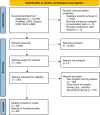What do we Know about Complex-Contrast Training? A Systematic Scoping Review
- PMID: 39333341
- PMCID: PMC11436572
- DOI: 10.1186/s40798-024-00771-z
What do we Know about Complex-Contrast Training? A Systematic Scoping Review
Abstract
Background: The complex-contrast training (CCT) method utilizes two exercises with different loads and movement velocities in a set-by-set fashion to induce multiple neuromuscular adaptations. The speculated primary mechanism involves the post-activation potentiation or post-activation performance enhancement (PAPE) of the muscles used during the heavy load (low velocity) exercise, thereby improving the performance of lower load (high velocity) exercise. However, no previous study has attempted to systematically synthesize the available evidence on CCT (e.g., if post-activation potentiation or PAPE was measured during the training sessions during the intervention period). This study aimed to synthesize the available evidence on CCT using a systematic scoping review approach. More specifically, we identified gaps in the literature using an evidence gap map (EGM), and provided future directions for research.
Methods: Three electronic databases (PubMed, Scopus, and Web of Science) were searched up to 20th February 2024. Data were extracted under a PICO framework: (a) Participants-related data (e.g., age, sex, type of sport); (b) Intervention-related data (e.g., duration of training); (c) Comparators (when available); and (d) Outcomes (e.g., measures of physical fitness). Interactive EGMs were created using the EPPI mapper software.
Results: From the 5,695 records screened, 68 studies were eligible for inclusion, involving 1,821 participants (only 145 females from 5 studies). All CCT interventions lasted ≤ 16 weeks. More than half of the studies assessed countermovement jump, sprint, and maximal strength performances. No studies were identified which examined upper-body CCT exercises alone, and no study assessed PAPE during the CCT sessions. Overall, the available evidence was rated with a low level of confidence.
Conclusions: In conclusion, whether CCT produces a PAPE that translates into longitudinal performance gains remains unclear. Moreover, the available evidence on the effects of CCT on various outcomes provides low confidence regarding the most effective way to implement this training method, particularly among females, and beyond long-term interventions.
Keywords: Exercise; Human Physical Conditioning; Muscle Strength; Physical Fitness; Plyometric Exercise; Team Sports.
© 2024. The Author(s).
Conflict of interest statement
Rohit K. Thapa, Anthony Weldon, Tomás T. Freitas, Daniel Boullosa, José Afonso, Urs Granacher, and Rodrigo Ramirez-Campillo declare that they have no conflicts of interest relevant to the content of this review.
Figures
References
-
- McGuigan MR, Wright GA, Fleck SJ. Strength training for athletes: does it really help sports performance? Int J Sports Physiol Perform. 2012;7(1):2–5. - PubMed
-
- Moir GL, Munford SN, Moroski LL, Davis SE. The effects of Ballistic and Nonballistic Bench Press on mechanical variables. J Strength Cond Res. 2018;32(12):3333–9. - PubMed
-
- Loturco I, McGuigan MR, Freitas TT, Bishop C, Zabaloy S, Mercer VP, et al. Half-squat and Jump Squat exercises performed across a range of loads: differences in mechanical outputs and strength deficits. J Strength Conditioning Res. 2022. 10.1519/JSC.0000000000004382. Ahead of print. - PubMed
-
- Cormier P, Freitas TT, Loturco I, Turner A, Virgile A, Haff GG, et al. Within Session Exercise sequencing during programming for Complex Training: historical perspectives, terminology, and training considerations. Sports Med. 2022;52(10):2371–89. - PubMed
Publication types
LinkOut - more resources
Full Text Sources
Miscellaneous



